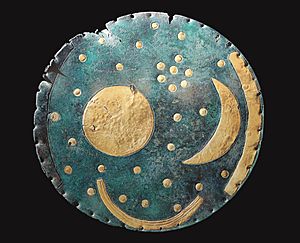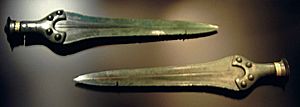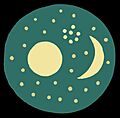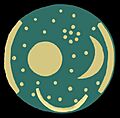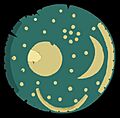Nebra sky disc facts for kids
The Nebra sky disc (called Himmelsscheibe von Nebra in German) is an amazing ancient object. It is a bronze disc, about 30 centimeters (12 inches) wide and weighs 2.2 kilograms (4.9 pounds). It has a beautiful blue-green color and is decorated with gold symbols.
These gold symbols are usually seen as the Sun or a full moon, a crescent moon, and many stars. One special group of seven stars is believed to be the Pleiades star cluster. There were also two golden arcs on the sides, but one is now missing. These arcs likely showed the path of the sun during the year, marking the solstices. A third arc at the bottom, with lines inside, is often thought to be a solar boat with oars. Some people think it might also be a rainbow or a comet.
This incredible disc was found in 1999 on a hill called Mittelberg, near Nebra in Germany. Archaeologists believe it was made around 1800–1600 BC, during the Early Bronze Age. It belonged to a group of people known as the Únětice culture. Many scientific tests have confirmed its ancient age.
The Nebra sky disc is special because it shows the oldest known picture of astronomical events from anywhere in the world. In June 2013, UNESCO added it to its Memory of the World International Register. They called it "one of the most important archaeological finds of the twentieth century."
Contents
How the Nebra Sky Disc Was Found
In 1999, the disc was found by two people using metal detectors. They were searching without official permission. Along with the disc, they found two bronze swords, parts of axes, a chisel, and pieces of spiral armbands. Sadly, they accidentally damaged the disc with their tools.
The disc and other items were then sold illegally. For a couple of years, they were passed between different people. In 2002, a state archaeologist named Harald Meller worked with the police. They managed to get the disc back from people who were trying to sell it.
The original finders were later identified. They helped archaeologists find the exact spot where the disc had been buried. This allowed experts to study the site properly. They found evidence that confirmed the disc's origin. Today, the Nebra sky disc and the other items are kept at the Halle State Museum of Prehistory in Halle, Germany.
The place where the disc was found is a special ancient area. It's on top of a hill called Mittelberg, in the Ziegelroda Forest. This area has many ancient burial mounds. It's thought that the sun sets behind the Brocken mountain, the highest peak of the Harz mountains, from this spot during the summer solstice.
How Old Is the Nebra Sky Disc?
Archaeologists used several methods to figure out the disc's age. The axes and swords found with it helped them. These items are typical of the period around 1700–1500 BCE.
Scientists also used radiocarbon dating on pieces of birch bark from the sword handles. This method showed the bark was from 1600 to 1560 BCE. This means the disc was buried around that time. It was probably already quite old when it was buried. Further tests on the metal and its surface also confirmed it was from the Early Bronze Age.
Where Did the Materials Come From?
Scientists studied the metals in the disc very carefully. They found that the copper used to make the disc came from a place called Bischofshofen in Austria.
Interestingly, the gold used for the symbols came from different places. Early studies suggested some gold was from the Carpathian Mountains. However, newer research shows that the gold used for the first decorations came from the Carnon River in southern Cornwall, England. The tin in the bronze also came from Cornwall. This shows that people in the Bronze Age traded materials over long distances.
How the Disc Changed Over Time
The Nebra sky disc wasn't made all at once. It was changed and updated in four main steps:
- First Stage: The disc originally had 32 small gold circles, a large gold circle, and a large crescent shape. The big circle is thought to be the Sun or full Moon. The crescent is the crescent Moon. The small dots are stars, and a group of seven dots likely shows the Pleiades star cluster.
- Second Stage: Later, two golden arcs were added to opposite sides of the disc. To fit them, some of the small gold circles were moved or covered up. These arcs are important because they show the angle of the sun's path between the summer and winter solstices. This angle matches the location where the disc was found.
- Third Stage: The last major addition was another gold arc at the bottom. This arc is often seen as a solar boat. It's believed to carry the sun across the sky.
- Final Touches: Before it was buried, about 38 to 40 small holes were punched around the edge of the disc. We don't know the exact number because the edge is damaged.
Why the Nebra Sky Disc Is Important
The Nebra disc is very important for several reasons. It likely had both a practical use for studying the sky and a religious meaning.
It shows that people in the European Bronze Age were skilled astronomers. They carefully watched the sun's path throughout the year. They knew the exact points where the sun rose and set during the summer and winter solstices. Ancient sites like the Goseck circle and Stonehenge also show this knowledge. But the Nebra disc is special because it's a portable object that holds this information.
The Únětice culture, who made the disc, also built large circular sites with astronomical alignments. These include places like Pömmelte in Germany. Some experts believe these sites share similarities with Stonehenge. This suggests a shared understanding of the sky across different ancient cultures.
The Disc as a Calendar
The way the Pleiades and a crescent moon are shown on the disc might be a rule for a calendar. This type of calendar, called a lunisolar calendar, combines both solar and lunar calendars. An ancient rule from Babylonia suggests adding an extra month when the Pleiades appear near a crescent moon in spring. This happens about every three years.
Some experts, like Harald Meller, think this knowledge might have traveled from Babylonia to Central Europe through trade. Ancient amber beads found in Iraq suggest connections between these distant regions.
The number of stars on the disc (32) might also be a clue. A lunar year is 11 days shorter than a solar year. It takes 32 solar years to equal 33 lunar years almost perfectly. This 32-year cycle might be shown by the 32 stars on the disc, plus the sun or full moon, making 33.
Ancient Beliefs and Mythology
The Nebra disc is seen as the oldest evidence of complex mythical beliefs in Europe.
Connections to Other Cultures
Similar pictures of a sun and crescent moon appear on a gold ring from Mycenae in Greece. This ring is from the 15th century BC. It shows a goddess holding poppies, possibly linked to nature and fertility. The gold arcs on the Nebra disc also look a bit like the Minoan double-axe, a symbol of a goddess.
Archaeologists like Kristian Kristiansen note that similar images are found in ancient rock carvings in Sweden. This suggests connections between different cultures across Europe.
The Solar Boat
The gold arc at the bottom of the disc is usually thought to be a mythological solar boat. This boat would carry the sun across the sky during the day and night. The small lines next to it might be oars.
Some believe this idea of a solar boat came from Ancient Egypt. However, others argue that sun-ships were already shown on gold objects from the Bell Beaker culture, which came before the Únětice culture. Solar boats also appear in later European myths, like in Latvian folk songs and Greek stories.
Divine Twins
The pairs of swords and axes found with the Nebra disc might represent Divine Twins. These are mythical figures, like the Dioscuri in Greece or the Ashvins in India. Similar pairs of items have been found in other Bronze Age burials.
Some experts think the constellation of Gemini, linked to the Divine Twins, might be shown on the disc. The large stone structures at Stonehenge might also represent an early form of these twins.
Connections with Britain
Some researchers, like Emília Pásztor, have questioned if the disc had a practical astronomical use. However, a similar gold object from Bush Barrow near Stonehenge also shows angles matching the solstices. This suggests both objects were designed to track the sun's yearly cycle.
Both the Nebra disc and the Bush Barrow object used gold from Cornwall, England. This shows a direct link between these distant places. The way the gold was added to the Nebra disc might also have come from Britain.
Authenticity of the Disc
When the disc was first found, some people wondered if it was a fake. One professor, Peter Schauer, even claimed he could prove it was a forgery. However, he later admitted he had never actually examined the disc himself.
Many scientists have studied the disc very closely. They looked at its surface and materials. Their scientific analyses have confirmed that the Nebra sky disc is indeed a genuine ancient artifact.
Exhibitions
The Nebra sky disc has been featured in many important exhibitions around the world.
- It was the main attraction in an exhibition called Der geschmiedete Himmel ("The forged sky"). This show displayed 1,600 Bronze Age artifacts.
- It was shown in Halle (2004-2005), Copenhagen (2005), Vienna (2005-2006), Mannheim (2006), and Basel (2006-2007).
- In June 2007, a special visitor center opened near the discovery site in Nebra.
- The disc is part of the permanent collection at the Halle State Museum of Prehistory.
- It was displayed at the British Museum in London for The World Of Stonehenge Exhibition from February to July 2022.
- It was also shown at the Drents Museum in Assen from August to September 2022.
Replica on the ISS
In November 2021, a copy of the Nebra Sky Disc traveled to the International Space Station (ISS). German astronaut Matthias Maurer took it with him on the SpaceX Crew-3 mission. Maurer was inspired by the disc when he designed his mission's patch. He also looked at the Pioneer plaques and Voyager Golden Records, which are messages sent into space from Earth.
Images for kids
-
Path of Vega at winter solstice, as seen from 51°N
See also
- Bush Barrow
- Bell Beaker culture
- Golden hat
- Rillaton Barrow
- Mold gold cape
- Trundholm sun chariot
- Tumulus culture
- Antikythera mechanism
- Tal-Qadi Temple – The Tal-Qadi Sky Tablet


